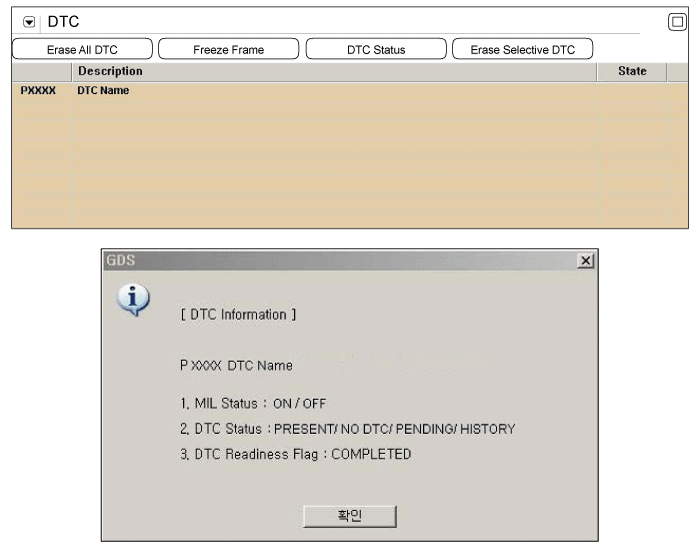
VIS(Variable intake
system) is a device which varies the length of intake manifold to genetate
maximum power at certain RPM. VIS lengthens intake manifold to improve the
torque at low RPM when vehicle speed is low while it shortens intake
manifold to raise torque at high RPM when vehicle speed is high. PCU
controlls VIS using RPM signal.
Checking the output
voltage from VIV(Variable Intake Manifold Valve) every 10 sec. under
detecting condition, if the value within detecting condition lasts for
more than 5 sec., PCM sets P0660. MIL(Malfunction Indication Lamp) turns
on when the malfunction lasts till consecutive 2 driving
cycle.
Item
|
Detecting
Condition
|
Possible Cause
|
DTC
Strategy
|
|
| •
|
Open or short in VIV
circuit |
|
Enable
condition
|
| •
|
After 0.5 sec under conditions
below |
| •
|
11V ≤ Battery voltage ≤
16V | |
Threshold
value
|
|
Diagnosis
time
|
| •
|
Continuous
(More than 5 seconds failure for every
10 seconds test) | |
MIL ON
condition
|
|
Item
|
Specification
|
Coil
Resistance (Ω)
|
30.0 ~ 35.0
Ω[22°C (71.6°F)]
|

| 1. |
Check DTC Status
| (1) |
Connect scantool to Data Link
Connector(DLC). |
| (3) |
Select "DTC" button, and then Press "DTC
Status" to check DTC's information from the DTCs
menu. |
| (4) |
Read "DTC Status"
parameter.

|
| (5) |
Is parameter displayed "Present
fault"?
|

|
▶ Go
to "Terminal and connector inspection"
procedure.
|
|

|
▶
Fault is intermittent caused by poor contact in the
sensor's and/or PCM's connector or was repaired and PCM
memory was not cleared. Thoroughly check connectors for
looseness, poor connection, ending, corrosion,
contamination, deterioration, or damage. Repair or
replace as necessary and go to "Verification of Vehicle
Repair"
procedure.
|
| |
| Terminal And Connector
Inspection |
| 1. |
Many malfunctions in the electrical system are
caused by poor harness and terminal condition. Faults can also be
caused by interference from other electrical systems, and mechanical
or chemical damage. |
| 2. |
Thoroughly check connectors for looseness,
poor connection, bending, corrosion, contamination, deterioration,
or damage. |
| 3. |
Has a problem been found?
|

|
▶ Repair as
necessary and go to "Verification of Vehicle Repair"
procedure
|
|

|
▶ Go to
"Power Circuit Inspection"
procedure.
|
|
■ Check voltage
| 1. |
IG "OFF" and disconnect VIV
connector. |
| 3. |
Measure voltage between power terminal of VIV
harness connector and chassis ground.
|
| 4. |
Is the measured voltage within
specification?
|

|
▶ Go to
"Control Circuit Inspection" procedure.
|
|

|
▶ Check
fuse connected to power of VIV for open or
blown-off.
▶ Repair open or short
to ground in harness, and go to "Verification of Vehicle
Repair"
procedure.
|
|
| Control Circuit
Inspection |
■ Check short to ground in harness
| 1. |
IG "OFF" and disconnect VIV connector and PCM
connector. |
| 2. |
Measure resistance between control terminal of
VIV harness connector and chassis ground.
|
| 3. |
Is the measured voltage within
specification?
|

|
▶ Go to
"Check open in harness" as follows.
|
|

|
▶ Repair
short to ground in harness, and go to " Verification of
Vehicle Repair"
procedure.
|
|
■ Check open in harness
| 1. |
IG "OFF" and disconnect VIV connector and PCM
connector. |
| 2. |
Measure resistance between control terminal of
VIV harness connector and VIV control terminal of PCM harness
connector.
|
| 3. |
Is the measured resistance within
specification?
|

|
▶ Go to "
Component Inspection" procedure.
|
|

|
▶ Repair
open in harness, and go to "Verification of Vehicle Repair"
procedure.
|
|
■ Check VIV
| 1. |
IG "OFF" and disconnect VIV
connector. |
| 2. |
Measure resistance between power and control
terminals of VIV connector.(Component side)
Specification
: 30 ~ 35 Ω
(22°C/71.6°F)
| |
| 3. |
Is the measured resistance within
specification?
|

|
▶
Substitute with a known - good PCM and ch
|
|

|
▶
Substitute with a known - good VIV and check for proper
operation. If the problem is corrected, replace VIV and go to
"Verification of Vehicle Repair"
procedure.
|
|
| Verification Of Vehicle
Repair |
After a repair, it is
essential to verify that the fault has been corrected.
| 1. |
Connect scantool and select "DTC"
button. |
| 2. |
Press "DTC Status" button and confirm that
"DTC Readiness Flag" indicates "Completed". If not, drive the
vehicle within conditions noted in the freeze frame data or enable
conditions |
| 3. |
Read "DTC Status"
parameter |
| 4. |
Is parameter displayed "History(Not Present)
fault"?
|

|
▶ System
performing to specification at this time. Clear the
DTC
|
|

|
▶ Go to the
applicable troubleshooting
procedure.
|
|